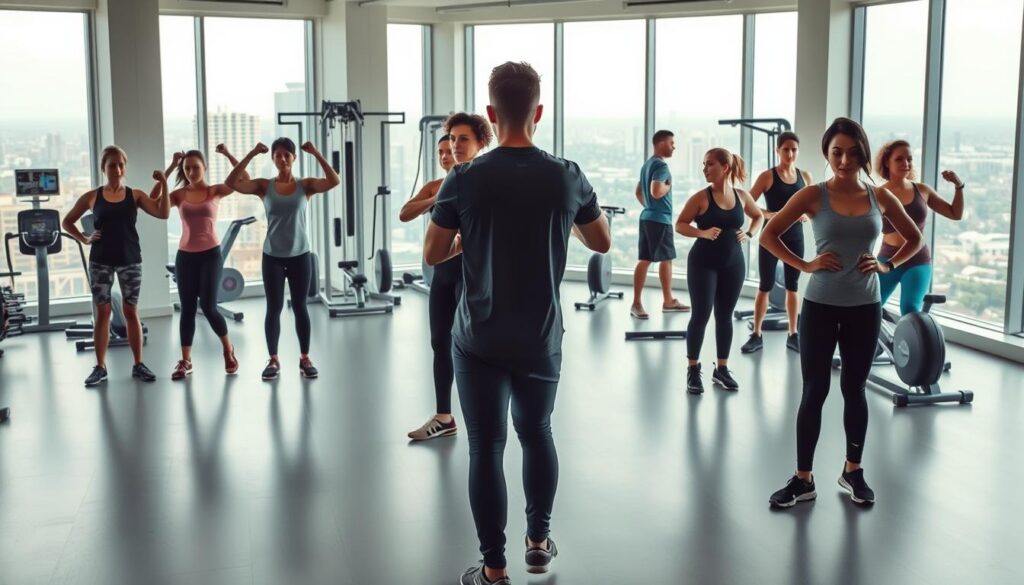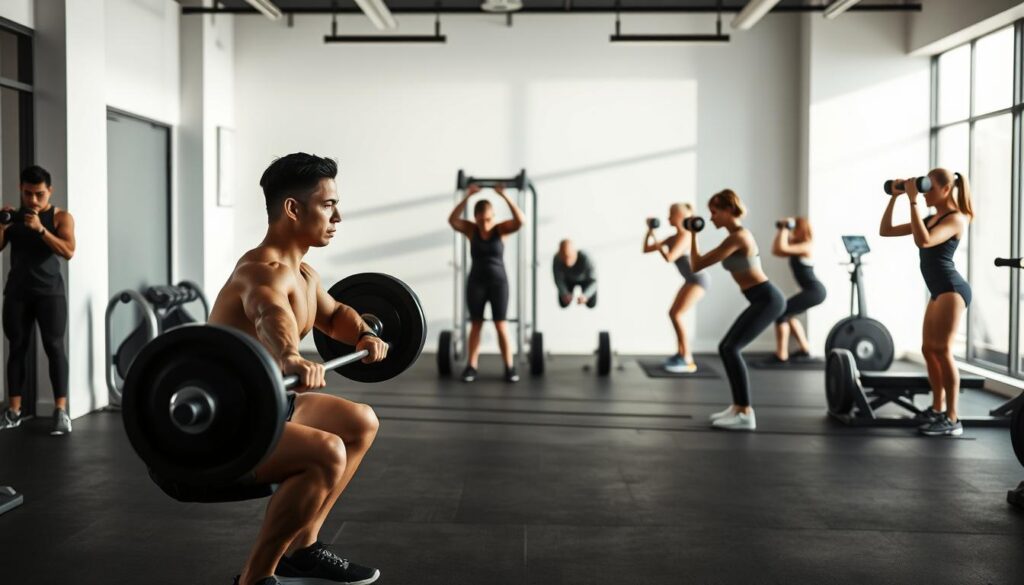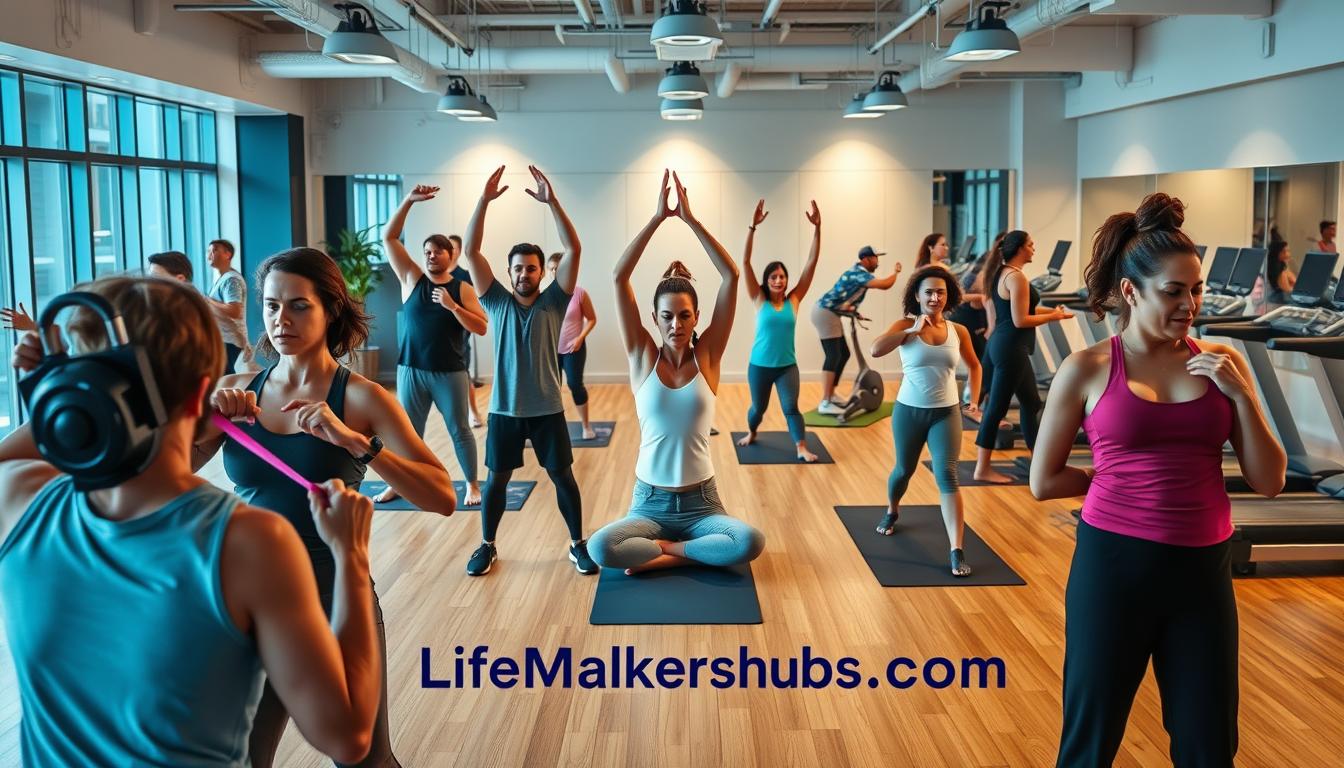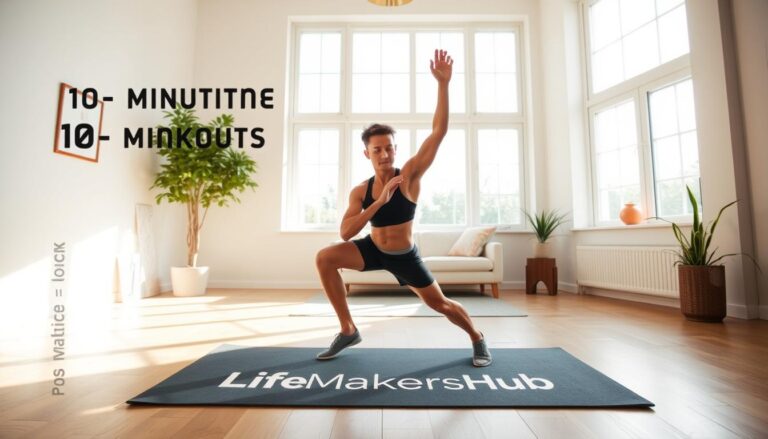Discover the Best Exercise Routines for You
Finding the right workout plan can feel overwhelming, but it doesn’t have to be. Whether you’re a beginner or an advanced fitness enthusiast, this guide is designed to help you achieve your goals. From building muscle to improving strength, we’ve got you covered.
Structured training is key to success. By focusing on proper form and intensity, you can maximize every set and rep. This approach not only boosts results but also reduces the risk of injury. Whether you prefer gym sessions or at-home workouts, there’s a plan for everyone.
Our expert tips and proven techniques will guide you every step of the way. From squats and lunges to dumbbell rows, each movement is tailored to help you reach your fitness goals. Let’s get started on your journey to a stronger, healthier you.
Key Takeaways
- This guide is designed for all fitness levels, from beginners to advanced.
- Structured workouts help build muscle, improve strength, and prevent injury.
- Proper form and intensity are essential for effective training.
- Both gym and at-home workouts are included to fit every lifestyle.
- Expert tips and proven techniques ensure optimal results.
Introduction to Customized Exercise Routines
Customizing your fitness plan is the key to long-term success. A one-size-fits-all approach rarely works because everyone’s body, goals, and lifestyle are different. By tailoring your workout to your needs, you can maximize efficiency and stay motivated.
What Sets This Ultimate Guide Apart
This guide goes beyond generic advice. It provides actionable steps to help you build a plan that fits your schedule, whether you’re at the gym or doing a home workout. From squats to planks, each movement is explained with clarity and precision.
Here’s what makes this guide unique:
- Focus on proper form to prevent injury and maximize results.
- Detailed instructions for rep and set progression.
- Options for both gym and home environments.
How to Use This Guide for Your Fitness Journey
Whether you’re a beginner or an advanced trainee, this guide is designed to grow with you. Start by assessing your current fitness level and setting realistic goals. Use the provided tips to adjust weight, sets, and reps as you progress.
Here’s a quick overview of what’s covered:
| Topic | Key Focus |
|---|---|
| Strength Training | Building muscle and improving arm and leg strength. |
| Bodyweight Movements | Effective home workouts with minimal equipment. |
| Progression Tips | How to increase weight and adjust sets over time. |
By following this guide, you’ll create a plan that’s as unique as you are. Let’s get started on your journey to a stronger, healthier you.
Benefits of Tailored Workout Programs

Personalized workout programs are the secret to unlocking your full potential. Unlike generic plans, these programs are designed to fit your unique needs, goals, and fitness level. Whether you’re aiming to build muscle, improve strength, or prevent injuries, a tailored approach ensures every movement counts.
Enhancing Muscle Growth and Strength Gains
Structured workout plans focus on progressive overload, which is key to building muscle and increasing strength. For example, dumbbell squats target your legs and core, while bench presses work your chest and arms. By adjusting weight, sets, and reps, you can continuously challenge your body and see steady progress.
Here’s how a tailored program can help:
- Focus on specific muscle groups like legs, arms, and back.
- Gradually increase weight and intensity to avoid plateaus.
- Incorporate compound movements like squats and rows for full-body benefits.
Preventing Injuries Through Proper Technique
One of the biggest advantages of a personalized plan is the emphasis on form. Proper technique reduces the risk of injury and ensures long-term progress. For instance, controlled push-ups and Romanian deadlifts teach you to engage the right muscles while protecting your knees and back.
Key tips for safe training:
- Start with lighter weights to master form.
- Focus on controlled movements rather than speed.
- Work with a trainer or use video guides for feedback.
Customized programs also allow adjustments as you progress. Beginners can start with basic movements and gradually add complexity. Advanced trainees can incorporate higher sets and reps to push their limits.
| Exercise | Target Area | Benefits |
|---|---|---|
| Dumbbell Squats | Legs, Core | Builds lower body strength |
| Bench Press | Chest, Arms | Enhances upper body power |
| Romanian Deadlifts | Back, Hamstrings | Improves posture and flexibility |
By following a tailored plan, you’ll not only achieve your fitness goals but also enjoy the journey. Whether you’re at the gym or doing a home workout, every session will feel purposeful and effective.
Effective Exercise Routines for Every Fitness Level
Your fitness journey starts with understanding your current abilities. Whether you’re just starting or have years of experience, matching your workout to your level ensures steady progress and prevents burnout. Let’s break down the key principles for beginners, intermediates, and advanced trainees.
Key Principles for Beginners, Intermediates, and Advanced Trainees
For beginners, focus on mastering fundamental movements like squats and dumbbell rows. Start with lighter weights and fewer sets to build confidence and avoid injury. As you progress, gradually increase the number of reps and add complexity.
Intermediate trainees should aim for progressive overload. Increase weight and add more sets to challenge your muscle groups. Incorporate compound movements like bench presses and lunges to target multiple areas, such as your legs, arms, and back.
Advanced trainees can follow a push-pull-legs split, training six days a week. Focus on heavy lifts like deadlifts and overhead presses, performing 5 sets of 5 reps for maximum strength gains. Rest intervals should be 60-180 seconds, depending on intensity.
Here’s a quick guide to adjusting your plan:
- Beginners: Start with 2-3 sets of 10-12 reps using lighter weights.
- Intermediates: Increase to 3-4 sets of 8-10 reps with moderate weights.
- Advanced: Aim for 4-5 sets of 5-6 reps with heavy weights.
Progression is the key to long-term improvement. Whether you’re at the gym or doing a home workout, focus on gradually increasing intensity and tracking your progress. This approach ensures you’re always moving forward, no matter your starting point.
At-Home Workouts and Bodyweight Movements
Transform your living room into a fitness studio with these effective at-home workouts. Whether you’re short on time or prefer the convenience of home, these routines are designed to deliver results. With minimal equipment and maximum efficiency, you can stay fit without stepping foot in a gym.
30-Minute High-Intensity Quickie Circuits
Short on time? Try a 30-minute high-intensity circuit that combines cardio and strength training. These quickie workouts are perfect for boosting metabolism and toning muscle. Start with bodyweight movements like squats, lunges, and push-ups. Add short bursts of cardio, such as jumping jacks or mountain climbers, to keep your heart rate up.
Here’s a sample circuit:
- 10 squats followed by 30 seconds of jumping jacks.
- 10 lunges per leg with 30 seconds of high knees.
- 10 push-ups paired with 30 seconds of rest.
Repeat this circuit 3 times for a full workout. Adjust the number of sets and reps based on your fitness level.
Bodyweight Alternatives and Minimal Equipment Options
No equipment? No problem. Bodyweight movements are versatile and effective. Focus on exercises like planks, squats, and lunges to target your legs, core, and upper body. For added resistance, use household items like water bottles or a backpack filled with books as makeshift dumbbells.
Here are some modifications for different levels:
- Beginners: Perform assisted squats using a chair for support.
- Intermediate: Add a jump to your lunges for extra intensity.
- Advanced: Try one-legged squats or explosive push-ups.
These home workouts are designed to fit seamlessly into your day. With consistency, you’ll see progress without sacrificing quality.
Designing Beginner, Intermediate, and Advanced Programs

Starting your fitness journey with the right program sets the tone for success. Whether you’re a beginner or an advanced trainee, structured plans ensure steady progress and prevent burnout. Let’s explore how to design programs tailored to your level.
Step-by-Step Beginner Routines
For beginners, focus on foundational movements like squats and dumbbell rows. Start with lighter weights and fewer sets to build confidence. Here’s a simple three-day full-body plan:
- Day 1: Barbell back squats (3 sets of 10 reps), dumbbell shoulder presses (3 sets of 12 reps).
- Day 2: Bodyweight lunges (3 sets of 12 reps per leg), push-ups (3 sets of 10 reps).
- Day 3: Dumbbell rows (3 sets of 12 reps), planks (3 sets of 30 seconds).
Track your progress by gradually increasing weight and reps. This approach builds muscle and improves strength safely.
Progressing to Intermediate and Advanced Challenges
Intermediate trainees should aim for progressive overload. Increase weight and add more sets to challenge your muscle groups. A four-day split works well:
| Day | Focus | Exercises |
|---|---|---|
| 1 | Upper Body | Bench press, dumbbell rows, shoulder presses |
| 2 | Lower Body | Squats, lunges, Romanian deadlifts |
| 3 | Upper Body | Push-ups, pull-ups, lateral raises |
| 4 | Lower Body | Deadlifts, step-ups, calf raises |
Advanced trainees can follow a push-pull-legs split, training six days a week. Focus on heavy lifts like deadlifts and overhead presses, performing 5 sets of 5 reps for maximum strength gains.
“Progression is the key to long-term improvement. Whether you’re at the gym or doing a home workout, focus on gradually increasing intensity and tracking your progress.”
By following these structured plans, you’ll achieve your fitness goals and enjoy the journey. Every session will feel purposeful and effective.
Mastering Proper Form and Exercise Technique
Proper form is the foundation of any effective workout, ensuring you get the most out of every movement. Whether you’re lifting weights or performing bodyweight exercises, maintaining correct alignment and control is essential. This not only maximizes results but also minimizes the risk of injury.
Common Mistakes to Avoid
Many beginners make simple errors that can hinder progress. For example, during squats, knees often cave inward, putting stress on the joints. Similarly, during dumbbell rows, arching the back can strain the spine. These mistakes are easy to fix with a little awareness.
Here are some common errors and how to correct them:
- Squats: Keep your knees aligned with your toes and engage your core.
- Bench Press: Avoid flaring your elbows; keep them at a 45-degree angle.
- Deadlifts: Maintain a neutral spine and hinge at the hips, not the waist.
Expert Tips on Maintaining Perfect Form
To ensure proper form, focus on controlled movements. For instance, during push-ups, lower your body slowly and pause at the bottom. This engages the muscle groups more effectively and reduces momentum.
Here are additional tips from experts:
- Use a mirror or video feedback to self-assess your technique.
- Start with lighter weights to master the movement before increasing intensity.
- Engage your core during every rep to stabilize your body.
Small adjustments can make a big difference. For example, keeping your chest up during squats improves alignment and reduces strain on your back.
“Good form isn’t just about looking right—it’s about moving safely and efficiently. Every rep counts.”
High-intensity training requires disciplined focus on form. Even when fatigue sets in, prioritize control over speed. This approach ensures long-term progress and keeps you injury-free.
Integrating Nutrition and Recovery into Your Routine
Fueling your body and allowing it to recover are just as important as the effort you put into your workouts. A balanced approach to nutrition and rest ensures you get the most out of every set and rep. Let’s explore how to optimize these elements for better results.
Nutrition Strategies for Muscle and Strength Gains
Your diet directly impacts your workout performance and recovery. Focus on consuming a mix of protein, carbs, and healthy fats to fuel your muscle growth. For example, a post-workout meal with lean protein and complex carbs helps repair and rebuild tissues.
Here are some simple meal planning tips:
- Include a palm-sized portion of protein like chicken or tofu in every meal.
- Pair it with a fist-sized serving of carbs such as quinoa or sweet potatoes.
- Add healthy fats like avocado or nuts to support energy levels.
Hydration is also crucial. Aim for at least 8-10 cups of water daily, increasing intake during intense training sessions.
Effective Rest and Interval Training Approaches
Rest is essential for preventing overtraining and injury. Schedule rest days to allow your body to recover fully. Active recovery, like light stretching or walking, can also help improve circulation and reduce soreness.
Interval training is another effective strategy. Alternate between high-intensity bursts and rest periods to maximize results. For example, try 30 seconds of sprinting followed by 1 minute of walking. Repeat for 10-15 minutes.
| Meal Time | Food Suggestions |
|---|---|
| Pre-Workout | Banana with almond butter, Greek yogurt with berries |
| Post-Workout | Grilled chicken with brown rice, protein shake with spinach |
| Snacks | Hard-boiled eggs, mixed nuts, hummus with veggies |
By combining smart nutrition with effective recovery strategies, you’ll enhance your fitness journey. Whether you’re at the gym or doing a home workout, these tips will help you stay on track.
Conclusion
Taking the first step toward a healthier you is easier than you think. Customized workout plans ensure every movement aligns with your goals, whether you’re building muscle or improving strength. By focusing on proper form and gradual progression, you’ll maximize results and stay injury-free.
Experiment with both gym and home workouts to find what fits your lifestyle. Start with lighter weights and fewer sets, then increase intensity as you progress. Consistency is key—track your improvements and celebrate small wins along the way.
Remember, your journey is unique. Whether it’s mastering squats or incorporating dumbbell rows, every step counts. Stay committed, and you’ll see lasting results. Start today and take control of your fitness journey!
FAQ
What makes this guide different from other fitness resources?
How can I use this guide to improve my fitness journey?
Are there workouts I can do at home without equipment?
How important is nutrition in achieving my fitness goals?
What should I focus on as a beginner?
How can I prevent injuries during my workouts?
Can I transition from beginner to advanced workouts?
What are some common mistakes to avoid during workouts?
Source Links
- How to Build an Exercise Plan – HelpGuide.org
- 10 Best Exercises for Everyone
- How To Build Your Own Workout Routine (Plans & Exercises)
- 5 steps to start a fitness program
- How to Start Exercising: A Beginner’s Guide to Working Out
- The Benefits of a Tailored Exercise Program
- Why a Tailored Fitness Plan Matters for Your Health
- Benefits of Personalized Training Programs – SVPT Fitness + Athletics
- Workout Routines for Men: The Ultimate Guide
- Try This 7-Day Workout Routine for Your Exercise Goals
- The Ultimate Home Workout for Each Fitness Level
- 31 Bodyweight Exercises to Pack on Muscle at Home
- The 10 Best at Home Workouts (No-Equipment!) | Nerd Fitness
- Training Priorities for Beginner, Intermediate, and Advanced Trainees
- Program Design for Transitioning from Beginner to Intermediate Lifting
- Mastering Foundational Exercise Form and Cues
- Developing Good Form & Exercise Technique
- Critical Cuing and Functional Training
- How to Incorporate Diet into Your Fitness Routine
- The Role of Nutrition and Exercise in Enhancing Recovery – Harmony Ridge Recovery Center
- Benefits of Exercise: MedlinePlus
- Creating a Sustainable Exercise Routine
- Exercise sustains the hallmarks of health







